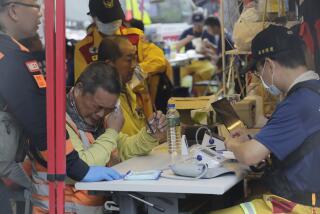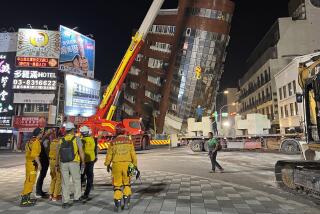New Zealanders dazed and exhausted by second big quake
- Share via
Reporting from Christchurch, New Zealand — Hannah Trusttun sat on a jagged stack of loose bricks Thursday, staring vacantly across a deserted downtown street in her devastated city.
It wasn’t supposed to be like this, the mother of two said. The place known as the Garden City, the gorgeous gateway to New Zealand’s South Island that draws tens of thousands of tourists each year, had become Earthquake City — again.
Just five months after a temblor shook Christchurch to its core, this city of 350,000 was hit Tuesday by another jolt, this time with far worse effects: 98 people confirmed dead, about 200 missing, 164 others sent to the hospital.
Authorities said as many as 120 people could be buried inside one building alone.
On Thursday, nearly 1,000 rescue workers from half a dozen countries continued searching the rubble in the city center for signs of life. Though they pulled several people to safety Wednesday, they know that each passing hour means less chance of success. Many collapsed buildings are now determined to be “unsurvivable.” Body bags have become a familiar sight.
New Zealand Prime Minister John Key declared the magnitude 6.3 earthquake, an aftershock of September’s quake, a national disaster, and analysts estimated its cost at as much as $12 billion.
For yet another day, Christchurch remained a place of immense danger and mounting death. Police have arrested a handful of looters and instituted a curfew in the downtown area, and tourists are scrambling to leave, many having lost their luggage and passports in the destruction.
For Trusttun and others, the damage is both physical and emotional. How do you forgive a hometown that, like a once-trusted but now-abusive parent, has pummeled you about the head?
Trusttun’s family of six has taken refuge in a tiny shed near their demolished home, without electricity or running water. One of her two children is sick, and she had heard a rumor that a pharmacy would open in the morning.
So she sat and waited, enduring one of the 24 aftershocks that hit between midnight and noon Thursday alone. She was shaded by a billboard encouraging Christchurch residents to keep their stiff Kiwi upper lip after the magnitude 7.1 quake that hit Sept. 4: “Rebuild, brick by brick,” it reads.
“You just get so tired,” Trusttun said. “Just when you get the feeling that all this uncertainty was coming to an end, another quake comes. Will it ever stop?”
On Thursday, a cozy downtown area normally bustling with pedestrians and trolley cars presented a snapshot of disaster, scenes left untouched since the earthquake struck during Tuesday’s lunch hour. A commercial drag on central Colombo Street had an end-of-the-world feel. Deathly quiet, with only the sound of a search-and-rescue helicopter overhead, time stood still.
At a shop called Pretty Things, mannequins lay across window sills amid shattered glass, resembling shooting victims. Nearby, a black pair of men’s dress shoes sat in front of a chair, as if their wearer had run off in panic. All along the street were bricks, the leftovers of facades that had toppled onto cars, exposing the rooms inside like life-size dollhouses. The large Cafe Valentine marquee had broken in two, one half resting against the street.
At Johnson’s grocery store, the toppled stock was waist-deep, much of it spilling outside. A jar of Really Good peanut butter. A box of Nestle’s Coco Shreddies cereal. Blocks away, the 27-floor Hotel Grand Chancellor, the city’s tallest building, imitated the Tower of Pisa, and authorities feared it could collapse.
Handyman Bill Straight wandered the street looking for his lost tools, jumping over three-foot fissures in the asphalt. He had been sweeping a shop floor when the quake hit, throwing him on his back. Now he stood outside a house cocked to one side like it was throwing a hip check.
“Look at that place,” said Straight, wearing a sweat-stained bush hat, his white beard in the shape of a locomotive cowcatcher. “It’ll be years. This town won’t be the same now, will it?”
Early Thursday, rescue crews on the day shift prepared to hit the streets. While some concentrated on collapsed buildings, others fanned out across the city, going door to door.
“People are still shocked. They’re coming to the door in tears, but they’re glad to see us, especially the older ones,” rescue worker Andrew Jolliffe said.
On Wednesday, rescuers pulled Ann Bodkin from the collapsed Pyne Gould Guinness building, which listed like the Titanic ready to slide into the deep.
Using high-tech listening devices, they heard the woman tapping on a slab of concrete. Hours later, they had identified her location and slowly inched her out of the rubble atop a stretcher, just as the sun broke through the rainclouds.
“They got Ann out of the building, and God turned on the lights,” Christchurch Mayor Bob Parker said.
On Thursday, paramedic team leader Murray Traynor said such rescues renew the workers.
“For rescuers, and for this entire city, events like that are incredibly important,” he said. “They raise morale and give us hope that there are others there as well.”
But officials know there are limits to the human spirit and ability to survive. Traynor said 100 hours was probably the longest a trapped person could make it, given enough air and lack of injury.
“The clock is ticking,” he said. “We know that.”
On Wednesday, two teenage children of a local TV newscaster waited for word outside the collapsed seven-story Canterbury Television building where their mother, Donna Manning, worked and where officials fear 120 people could be under the rubble.
“My mum is superwoman, she’d do anything,” one of the teens told reporters, tears streaming down her face.
Just then, a police officer approached and knelt before the family in the rain. “I have some horrible news,” the officer began.
There was no hope of any survivors, he explained. The teens crumpled in grief.
As many of the dead remain unaccounted for, the living try to regain their hold on life. Carlis Ioannis, a 66-year-old Greek immigrant, swept the shattered pottery on his front walkway, fighting back tears. The quake had broken a lifetime collection of rare pieces from Greece and elsewhere and made his small apartment unlivable.
He showed a visitor toppled masonry and the shards that litter his former home. Divorced, the former Greek-language teacher says he has no one to look after him.
He asked a visitor for tips on city shelters. He went back to sweeping but, at the last moment, looked up and uttered words common among residents of this quake-struck city.
“Please,” he said. “Don’t forget about me.”
More to Read
Sign up for Essential California
The most important California stories and recommendations in your inbox every morning.
You may occasionally receive promotional content from the Los Angeles Times.











